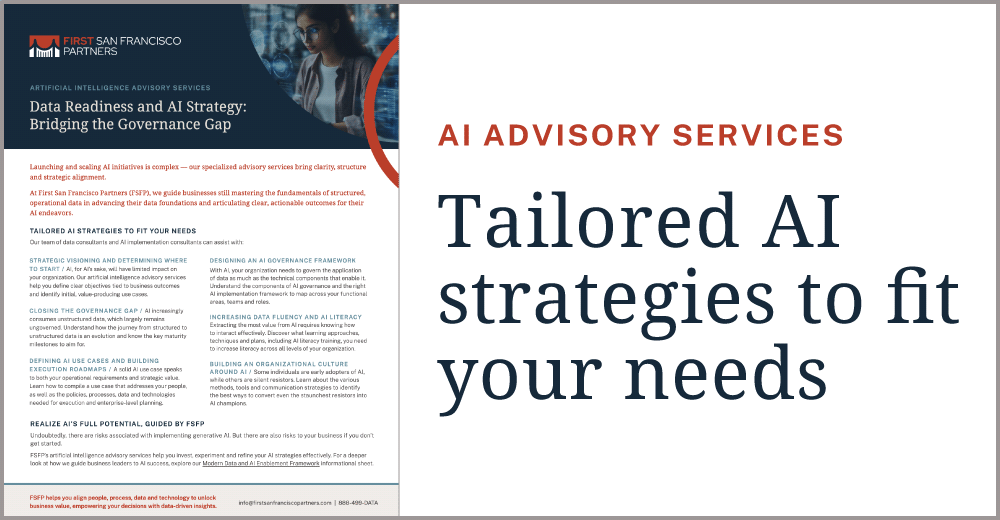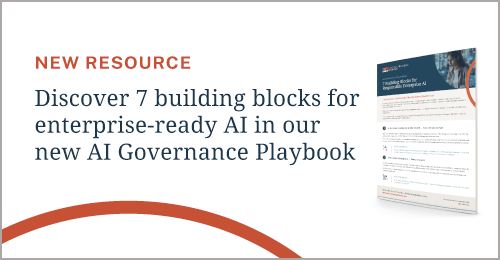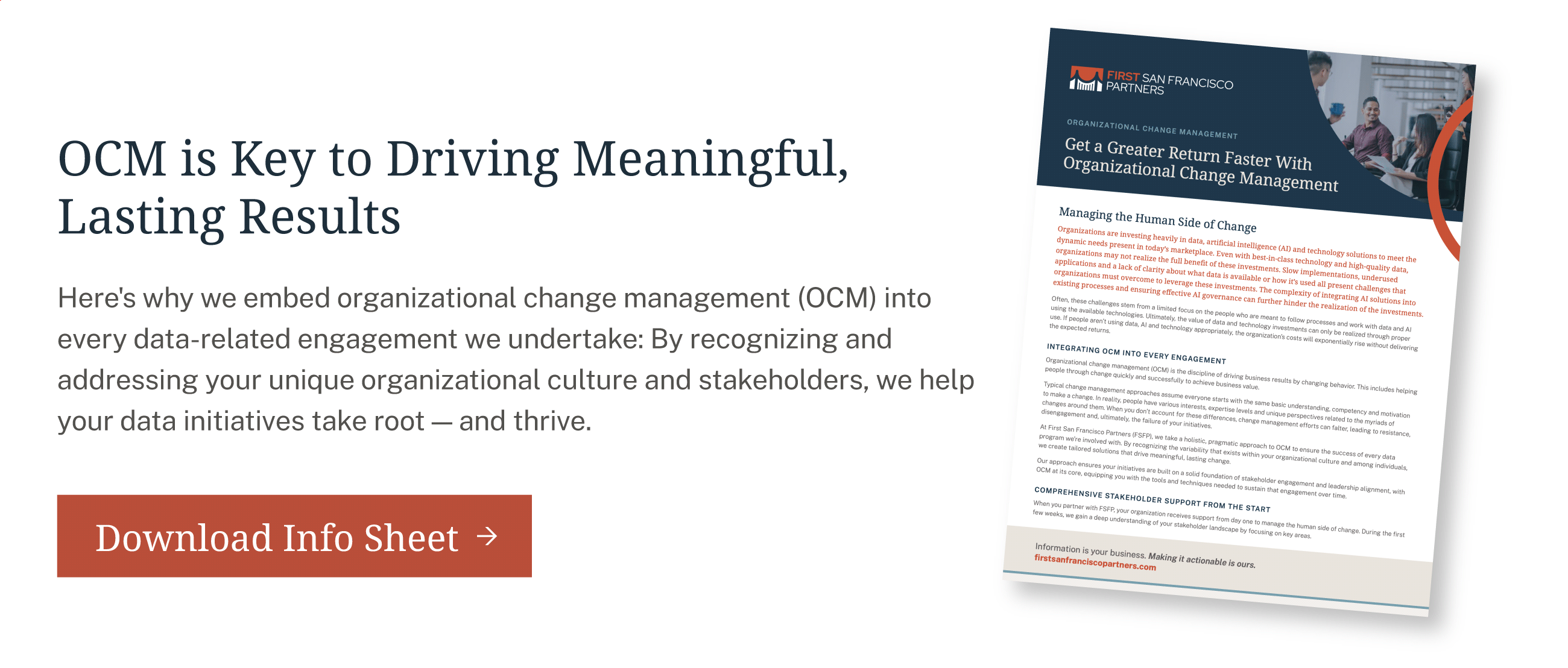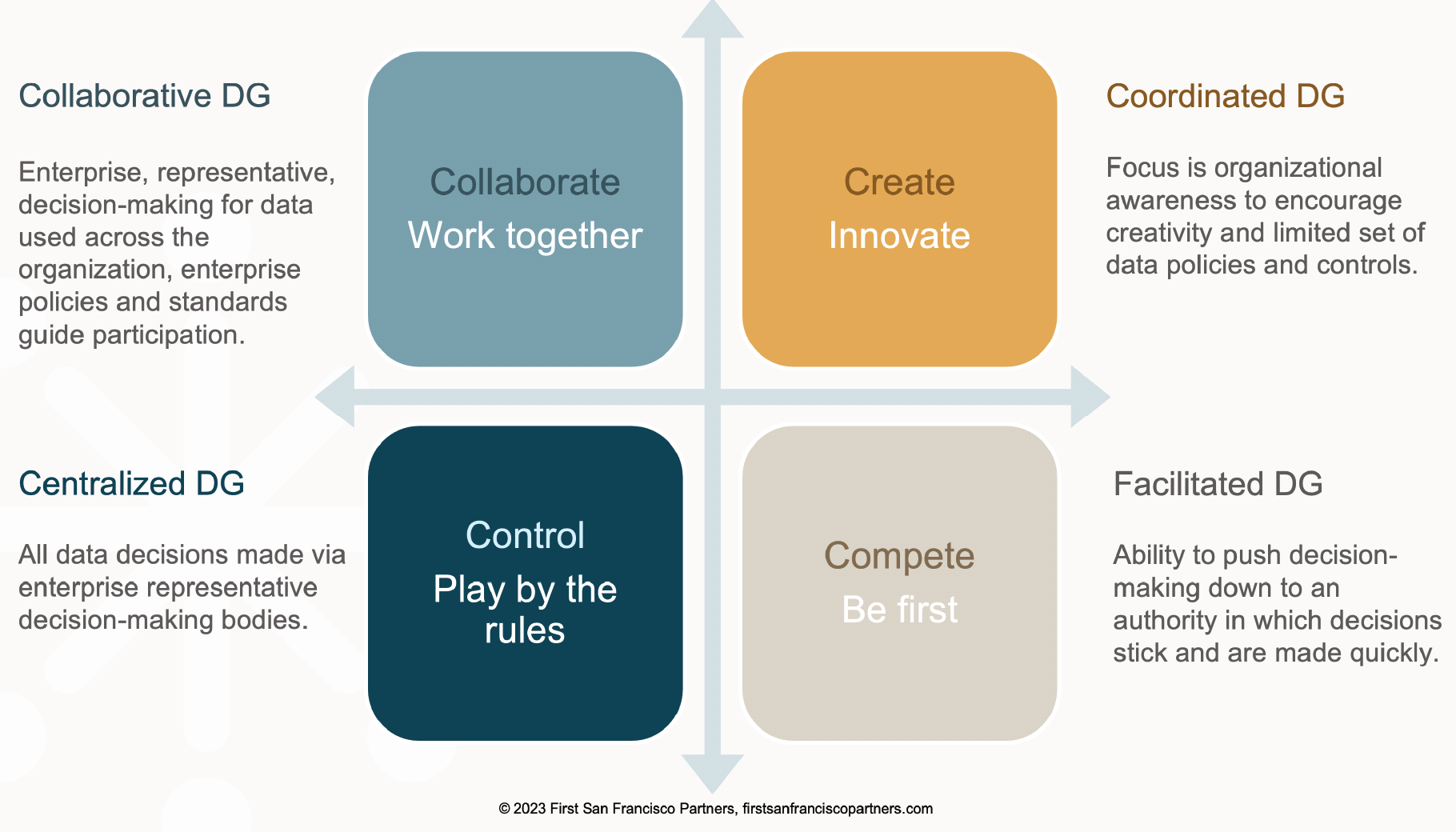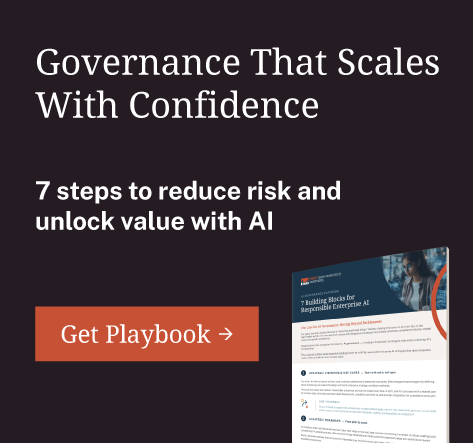Does having a data-driven culture sound like your idea of nirvana? Sounds heavenly to me.
In a data-driven culture, everyone optimizes data to deliver on the organization’s objectives. They’re focused on data governance’s success and don’t even know they’re doing it. (Unless they’re part of the data governance team, of course!) Everyone knows data is an asset that delivers business value and is part of the organization’s culture.
The Ideal Culture: An Orchestra or Music Festival?
Many businesses try to develop a data-driven culture, but their efforts don’t stick. There are success stories, though, because I see it in companies First San Francisco Partners work with.
Setting data aside for a moment — when you think of the ideal organizational environment, how would you define its culture?
Is it ...
Collaborative?
Formal or informal?
Entrepreneurial?
Cutting edge or bleeding edge?
Friendly?
Focused?
Committed?
Many of us will imagine an organization where everything runs like clockwork. Everyone knows their job and how they enable others to do theirs. This culture is like an orchestra where talented players create and deliver the best music for the audience.
Or maybe this is your ideal: The organization’s culture allows for more fluidity, leaving room for improvisation. Individual players, bands and audience members find their own interests without feeling fenced in — like a music festival.
Neither of these cultures is necessarily better than the other. Whether it’s the orchestra or music festival, both scenarios require everyone to be on the same page and working toward the same goal to create music people want to listen to. But how they get to that goal is different.
The same is true of our individual organizations. Our cultures may look different, but we all want to work toward doing more and doing things better together.
Culture is the set of shared attitudes, values, goals and practices that characterizes an institution or organization.
Culture’s Often Hidden in Plain Sight
Defining your culture’s style can be hard when you’re part of it.
When speaking to the graduating class of Kenyon College in 2005, writer and professor David Foster Wallace quipped that fish don’t know they’re in water. Wallace noted the point of the fish story as this: “The most obvious, important realities are often the ones that are the hardest to see and talk about.” They’re literally the background and part of the patterns and stories we often don’t notice or focus on.
Culture is the human version of water. We learn what’s innate by watching and observing the world around us, and we rarely stop to consider what it means — how it became “normal” and influences our interactions, policies and decisions.
Often, this means we miss important parts of our culture — aspects that, if we could draw them out from the background, would allow us to see things in new ways and open the doors to innovation.
Becoming data-driven is about leveraging your culture to bring your organization along rather than working against it.
Culture and Data Governance
Because culture is so strong and potentially ambiguous, when we implement data governance (DG), we aim to leverage our organizational culture to collaborate with us instead of forcing it into something. Even when our end goal requires a slight change in how we work, we must leverage our existing culture and how it works to succeed.
If you’re reading this because you’re trying to implement DG, data management or another type of “transformational change,” what follows are tools to help get you there (wherever there is). You can use these tools no matter where you are in your governance journey — whether just getting started or ready to take off and fly.
Organizational change management (OCM) is the discipline of driving business results by changing behavior. This includes helping people quickly and successfully through change to achieve business value.
Recognize, Organize and Mobilize
To be intentional about how you shape your organization’s data-driven culture:
- Recognize and leverage your environment, being thoughtful about how you shape your culture and not work against it.
- Organize decision-making and participation to build on cultural strengths.
- Mobilize your organization by strategically deploying tools like data literacy and OCM.
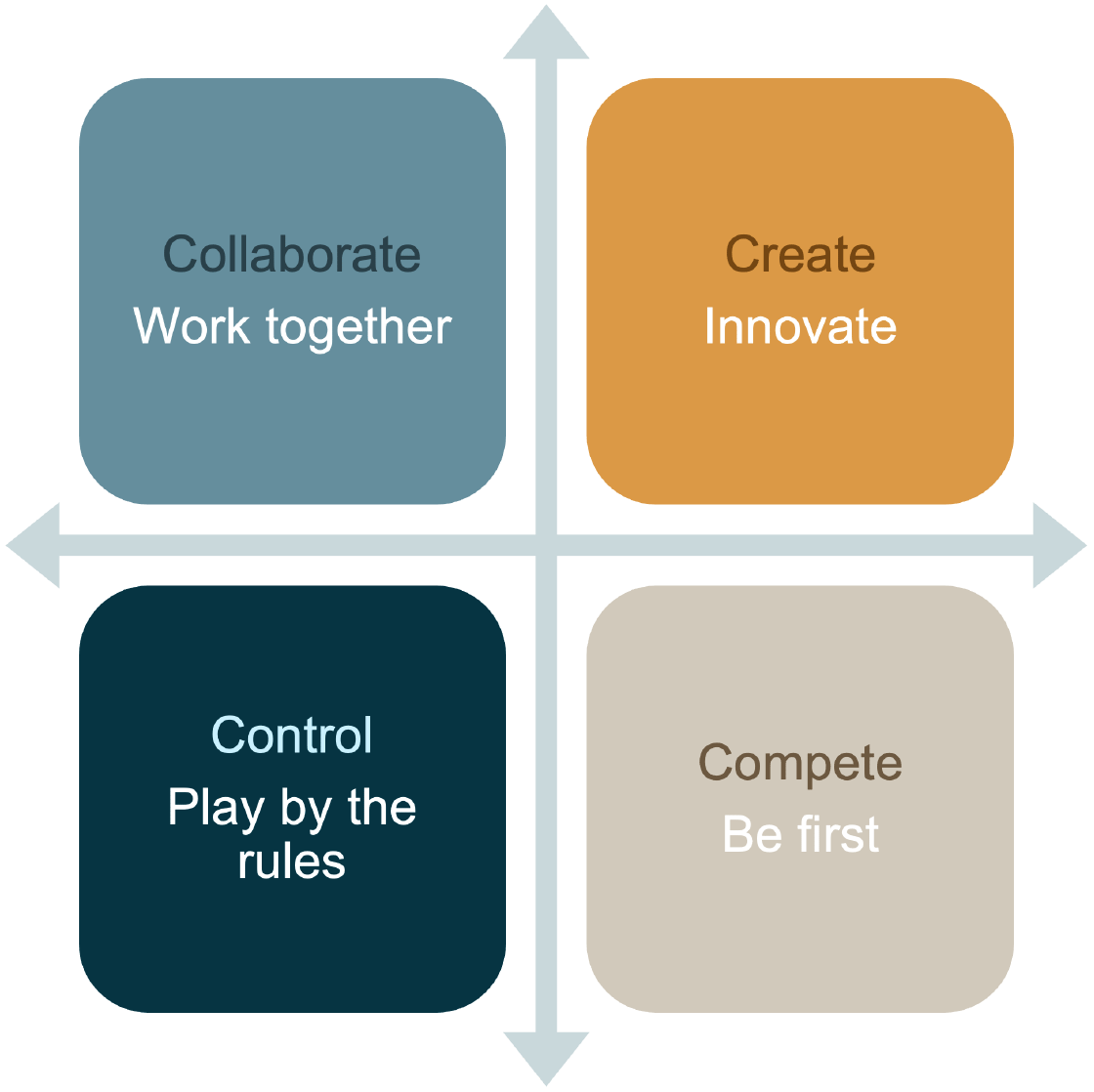
Competing Values Framework image inspired by: Cameron, K. (n.d.), An Introduction to the Competing Values Framework. Haworth.
• Recognize
There are many ways to think about and categorize organizational culture, and the Competing Values Framework* (CVF) is just one. CVF was developed by Robert Quinn and John Rohrbaugh, faculty in Public Administration at SUNY-Albany, in the early 1980s in their work around organizational effectiveness. It continues to be used today to identify levers of change.
Drs. Quinn and Rohrbaugh noted that “organizational effectiveness is a value-based judgment about the performance of an organization,” which is why it’s so important to identify and recognize your culture — the “lived” representation of organizational values, not just what’s in your annual report but what’s manifest in the way you work.
There’s nothing inherently right or wrong about any of the quadrants in the CVF — a collaborative culture is not necessarily better than a competitive culture — but they point to different opportunities and tactics for enabling change. If your organization is a “do things first” (Competitive) company, attempting to implement a new change with a “do things right” or “play by the rules” (Control) approach will meet with resistance.
Work within your organization’s creative culture to boost your chances of success.
Now, let’s dig into the CVF framework for DG shown above.
– A Collaborative Culture values team participation and finding consensus on decisions. It focuses on effective relationships and talent management. In this environment, committees are standard and tend to be great ways of sharing information and problem-solving.
This quadrant’s governance program should leverage participation through committees to create enterprise policies and standards that get everyone on the same page. In this environment, it may be more time-consuming to make decisions or develop data definitions — but once they’re made, they tend to stick because many people were involved in that process.
– A Create Culture prioritizes innovation, is entrepreneurial and is willing to fail fast. In this environment, the focus is on a minimum number of policies and controls. It’s an excellent environment for compelling and meaningful guiding principles to steer the decision-making around data. In an informal environment without many policies and standards, encouraging people to govern data will be even more critical by demonstrating its benefits and value to the organization and its people individually. And most importantly, there is an opportunity to tap into that innovation to help build the new DG capability.
– A Compete Culture is characterized by a relentless pursuit of being "the first" at everything, unwavering commitment to goal achievement and an inherent sense of competitiveness. In this environment, the ability to make swift decisions is paramount. To facilitate this, decision-making authority is delegated to the lowest level possible of the organization. The “lowest level” should be the level closest to where the work is done and where a decision will remain fixed, preventing further deliberations once decisions are made. This approach ensures the right decision-makers are engaged, minimizing the need for reevaluation and allowing the organization to maintain its competitive edge in its fast-paced landscape.
– A Control Culture is the most formal of the quadrants; it’s focused on establishing a bureaucratic yet efficient structure. This works well in highly regulated environments like government, financial services or healthcare, although I’ll caution you that not all organizations in these industries fall into this quadrant. This culture’s DG programs tend to be more top-down and focus on the control aspect of governance versus the optimization aspect. (I’ve heard it expressed this way: If the brakes work well on a car, then the driver can go faster.)
Your organization may exhibit characteristics from multiple quadrants. So, identify the quadrant that aligns with the most dominant characteristics of your organization.
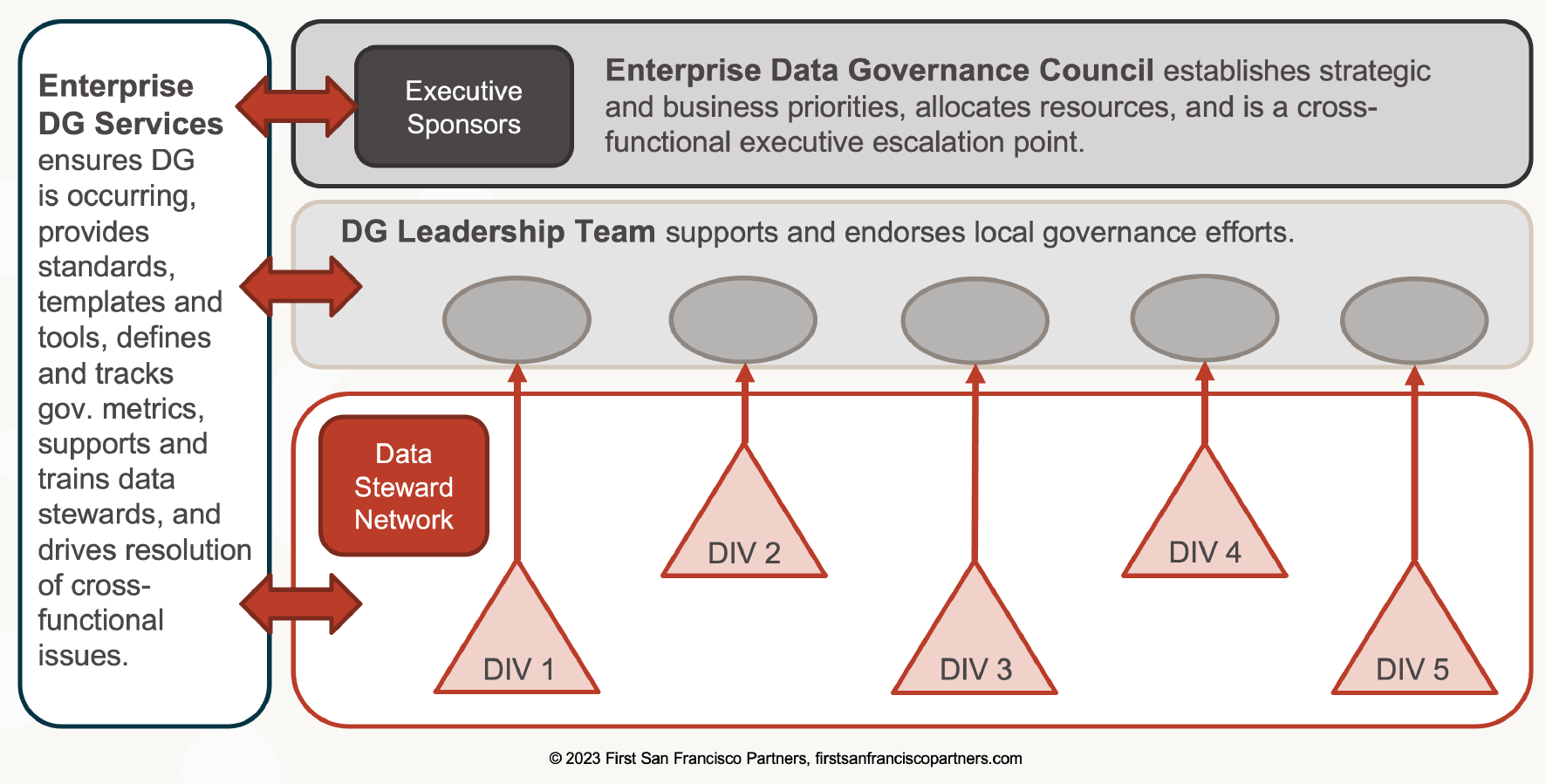
Facilitated Enterprise Data Governance Operating Model Example
• Organize
Governance structure comes next, where you organize your decision-making and participation to build on your culture’s strengths.
The above image exemplifies a DG operating model from a financial services firm whose culture fits the Compete or “be first” quadrant. The organization has distinct and independent lines of business and rewards entrepreneurialism and independent thinking to accomplish its goals. You wouldn’t use the word collaborative to describe the company, although within the lines of business and specific team, they do work together.
This organization’s governance operating model reflects the uniqueness and independence of its lines of business and empowers the individual data stewardship teams with most of the decision-making. It surrounds them with support and high-level strategic direction, policies and standards to maintain basic interoperability and efficiency. Representatives from each stewardship team meet regularly in a lead steward forum, where cross-area issues are raised and resolved. Should there be a need for additional escalation, the Enterprise DG council, which comprises representatives from each team, is empowered to make decisions when everyone can’t come to an agreement.
The Compete (be first) organization values agility and has structured its operating model so that the day-to-day work of the stewardship teams is largely encapsulated. They provide clear strategic direction and set policies and standards but leave details to the stewardship teams to resolve.
This organization feels a bit more like the music festival with lots of options, and people can choose what they want to do. But there’s still over-arching coordination, support and structure.
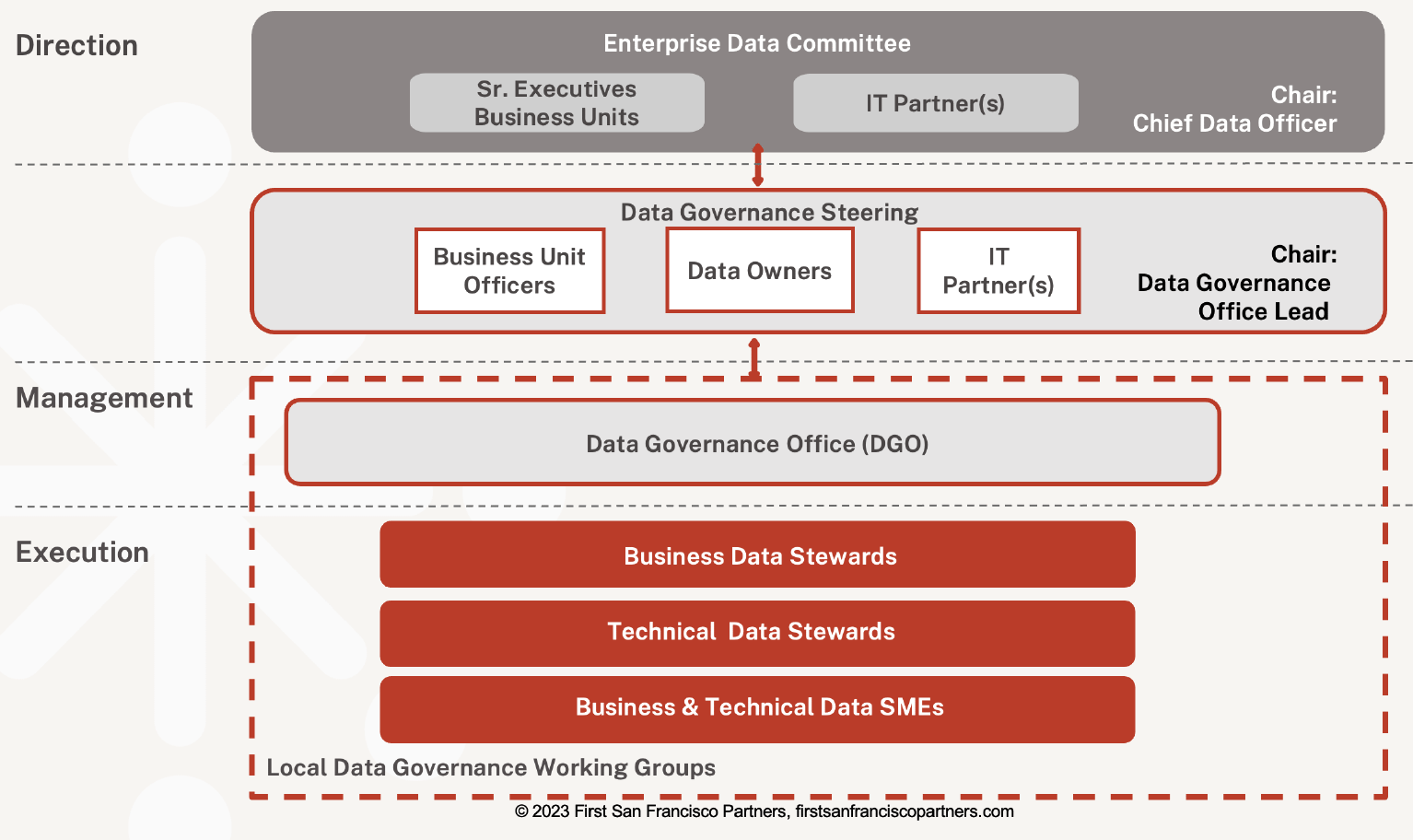
Centralized Enterprise Data Governance Operating Model Example
The above example is a DG operating model from another financial services firm whose culture fits the Control (play by the rules) quadrant. This well-established, global financial organization places a high priority on risk management and regulatory compliance. Its culture is one where people expect to know in no uncertain terms their roles and responsibilities and the chain of command for decision-making. Like the orchestra, this organization is one where everyone knows their part and how it contributes to making the whole organization work as efficiently as possible.
In this culture model, all enterprise DG work flows through a centralized governance office responsible for ensuring all business and technical stewards and subject matter experts follow organizational policies and standards determined by the DG steering committee.
The accountability levels are:
- Strategic: Provides overall strategic direction, budget and resource approvals. Forum for issue-escalation. Approval of data domains under governance control.
- Executive: Provides program oversight. Allocates budget and resources. Empowers business data stewards. Forum for issue-escalation.
- Management: Crafts enterprise data strategy, processes and standards to ensure data is managed as an asset.
- Tactical: Stewards data within business units. Ensures enterprise policies, standards and processes are applied.
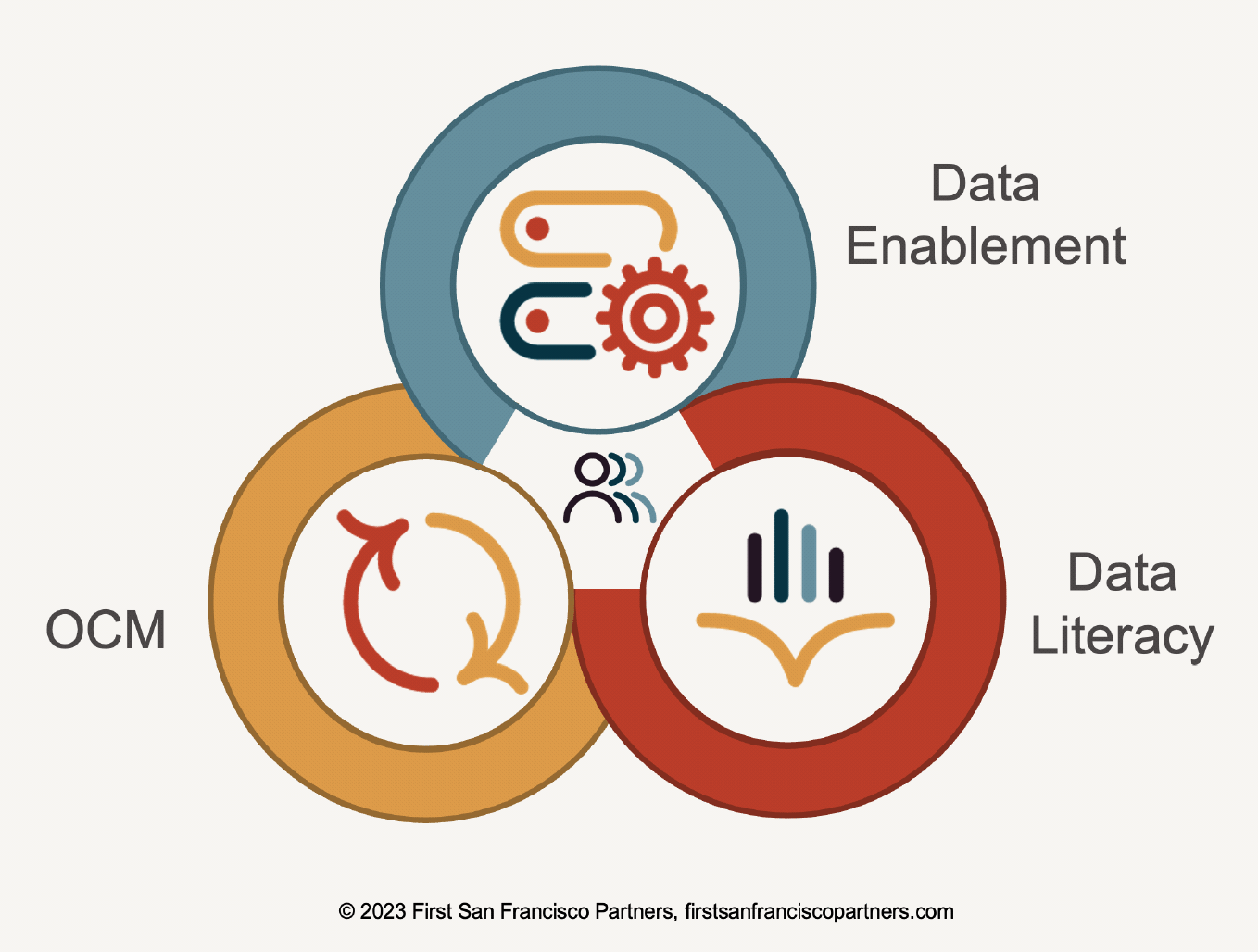
Three Elements That Drive Culture Change Around Data
To Be Continued ...
In a follow-up article on FSFP’s blog, I’ll cover the third piece of data-driven culture work that follows Recognize and Organize — Mobilize — and the key strategies that drive culture change around data:
- Data enablement – Access to the right data at the right time for the right purpose by the right people
- Data literacy – The ability for individuals to effectively use and communicate with data
- Strategic OCM – Help people understand the required changes and how to achieve them and how reinforcement ensures changes stick
Mobilizing your organization’s employees to be the agents of transformation in your data-driven journey may be the most challenging part of the process. But it can be the most rewarding and lasting.
I hope you’re subscribed to FSFP’s newsletter so you can be notified when part two of my article is online. Please sign up here if you’re not a subscriber.
* Research citation: A Competing Values Approach to Organizational Effectiveness Author(s): Robert E. Quinn and John Rohrbaugh Source: Public Productivity Review, Jun. 1981, Vol. 5, No. 2, A Symposium on the Competing Values Approach to Organizational Effectiveness (Jun. 1981), pp. 122-140 Published by: Taylor & Francis, Ltd. Stable URL: https://www.jstor.org/stable/3380029
This article was inspired by my Walk, Run, Fly to a Data-Driven Culture presentation at DATAVERSITY's June 2023 Data Governance & Information Quality (DGIQ) Conference. It's a great event and one FSFP never misses. The next DGIQ is this December, and here's where you can get information about it.
Array
